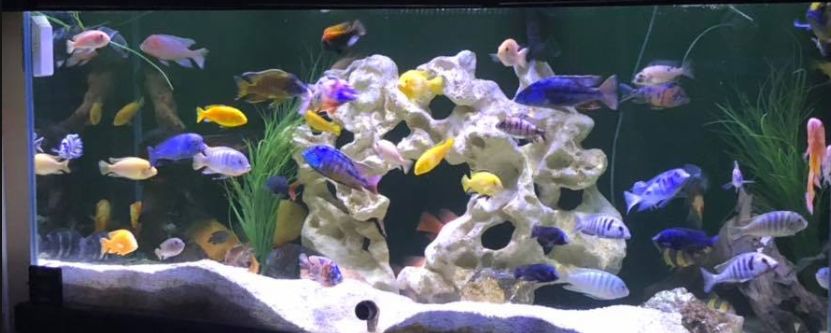
This is a very long and boring discussion of the very charged and opinionated topic of proper stocking of the aquarium. This article tackles the problem from a scientific viewpoint. This is very long winded discussion only for real nerds, like the author.
The Science
Note that there is some science here. And the science says that VERY VERY HEAVY stocking of aquarium tropical fish is quite healthy and does little harm to the fish
Universities that raise zebrafish for research use a figure of five to fifteen zebrafish per liter (19 to 57 per gallon) as the optimum stocking. That is 1,895 to 5,685 one-inch zebrafish per 100 gallons, two to six times the stocking level of my “heavy” level. Consider that these universities need to keep these fish healthy to do their research. So they have done a lot of research which shows their stocking to be reasonably sound for fish health.
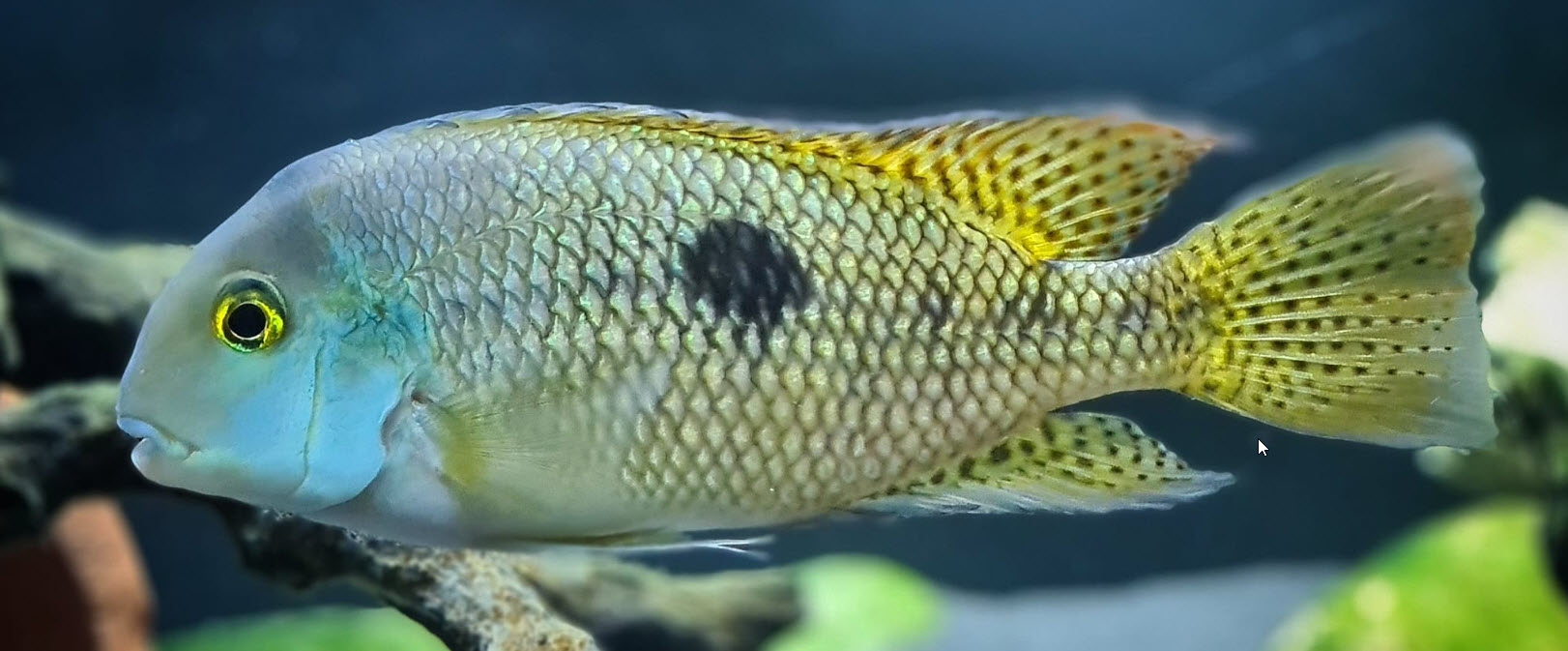
“The Effect of Stocking Densities on Reproductive Performance in Laboratory Zebrafish (Danio rerio)”, Castranova et. al., 2011.
“These data suggest that using stocking densities as high as 12 fish/L (46 per gallon) does not hurt performance, when measured by reproductive performance”.
“Husbandry of Zebrafish, Danio rerio, and the Cortisol Stress Response”, Pavlidis et. al. 2012.
“It is concluded that adult laboratory zebrafish had a preference for a transparent or black background aquarium, at several 10 individuals per 2 L (20 per gallon) of available water volume, to express their normal behavior and avoid increased cortisol stress reaction.”

“Effects of Stocking Density on Growth of Zebrafish”, Rabbane e. al., 2016
“The result of this study suggests that the stocking density of zebrafish could be 15 fish per 2 litres (29 per gallon) of water in a laboratory system with aeration”.
Comment from Shea
“I just wanted to jump in as a zebrafish/zebra danio researcher to add some more specifics onto how heavy we’re able to stock our fish.
It’s not uncommon for us to stock 200+ adult zebrafish in 15 gallon (13 per gallon), bare bottom tanks. Our fish turn out fine morphologically/genetically, and are healthy for many years (healthy meaning able to spawn 50+ viable embryos. Some of our best breeders are 5+ years old).
The one caveat to this is that we house our fish in expensive commercial systems designed to maintain precise water parameters. These systems are also equipped with massive (25 gal+) fluidised K1 sumps.
While obviously not representative of any home aquarium… The point I’m trying to make is that good biofiltration allows you to “get away” with a lot.”
Aquaculture operations raising food fish like tilapia for consumption can run a very high stocking. And aquaculture operations run on very thin margins which will be negatively impacted by any fish death. A quote is useful:
“How many tilapia per gallon?
The consensus is that a pound of tilapia will need 3 gallons of water. A full-grown tilapia will weigh approximately 1 pound although they can grow larger.”
This is one pound of fish for every three gallons of water or 33 pounds per 100 gallons. The heaviest level shown in the charts below is for stocking 6.1 pounds of fish for every 100 gallons. So obviously even the heaviest aquarium loading here is well below the level where fish health becomes a concern.
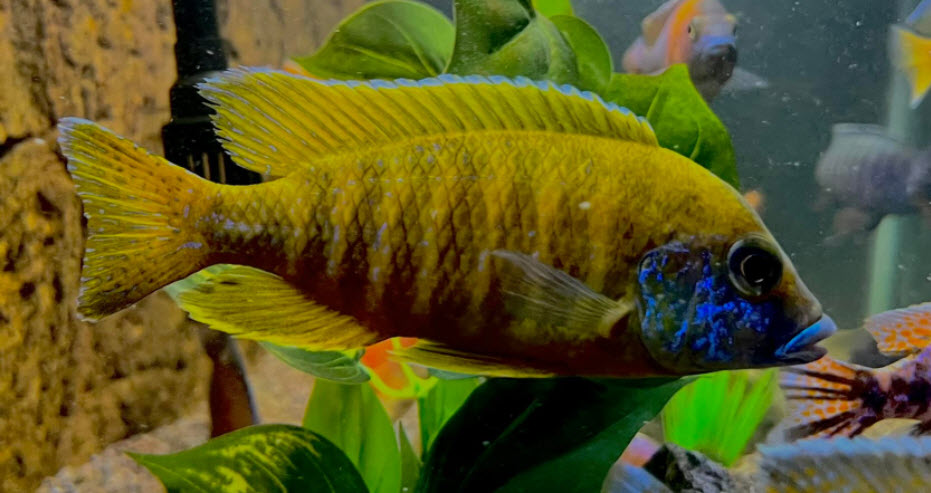
One Inch of Fish for Every Gallon of Water
The basic stocking “rule” (actually simply an OPINION) that has prevailed forever is “one inch of fish for every gallon of water”. This is extremely inaccurate. It is the volume and weight of a fish, not its length, which is important.
Using the metabolic weights of the fish (calculated elsewhere), the one inch per gallon rule in a 100 gallon aquarium (100 inches of fish) will give
- one inch fish – 100×1 gram = 100 grams of one inch fish (light stocking)
- two inch fish – 50×7 grams = 350 grams of two inch fish (moderate stocking)
- four inch fish – 25×47 grams = 1,175 grams of four inch fish (heavy stocking)
- eight inch fish – 13×167 grams = 2,171 grams of eight inch fish (VERY heavy stocking)
This illustrates how inaccurate this “rule” is. The number of grams should be equal in my OPINION. But for small one to two inch fish and beginners this is a good rule. It rapidly breaks down above 2 inches. Beginners to the hobby and those that have new aquariums with new filters should not be doing any heavy stocking.
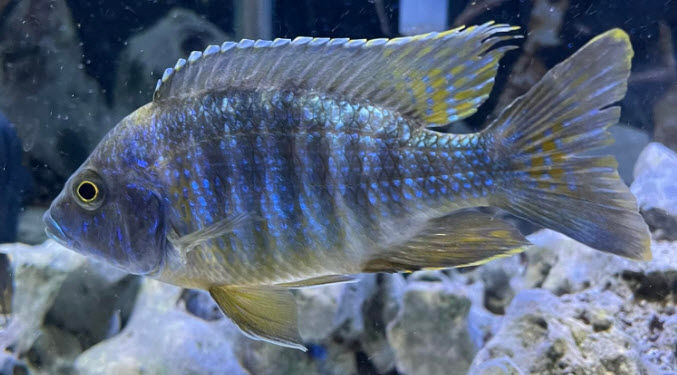
Rachel O’Leary Methodology
Rachel O’Leary (great YouTube channel) looks at each fish and calculates its “volume” in “cubic inches” (length multiplied by height multiplied by width). An “average” fish will weigh ten grams for each calculated “cubic inch”. So
- a “normal fish” a five-inch peacock (including tail) is 5 inches by 1.5 inches tall by half an inch wide gives 5×1.5×0.5=3.75 – 3.75x 10=38 grams.
- A five-inch discus (including tail) which is 3.5 inches high and 3/8ths of an inch wide is 5×3.5×0.375=6.6 – 6.6×10=66 grams.
- A five inch fancy goldfish is 5×1.6×1.6=12.8 – 12.8×10=128 grams.
This “rule” is surprisingly accurate. Rachel O’Leary then uses an OPINION of recommended stocking being equal to one “cubic inch” or ten grams of this “volume” of fish for every ten gallons, which works out to ten “cubic inches” or 100 grams to a 100-gallon tank.
This is a great method for very accurately determining the filtration requirements and the true stocking ratio. Note this is roughly 5% of the “heavy” stocking of the author’s OPINION below. But Rachel breeds fish. Breeding typically requires very low stocking.
Note also that I put the “volume” in quotes as the “true volume” of the actual fish is very very roughly 61% of the volume calculated by Rachel’s methodology.
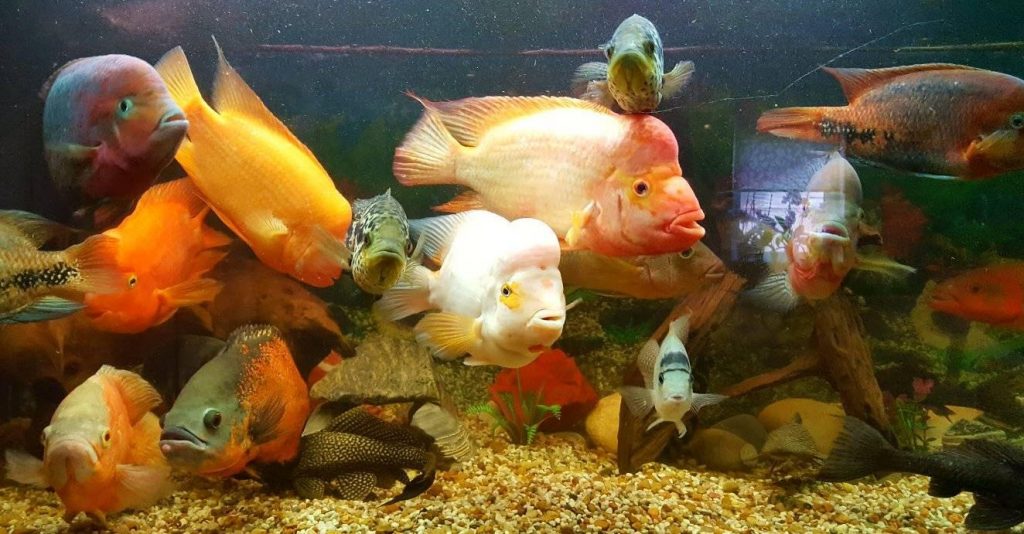
Calculating Stocking Ratio in Depth
The best way to look at stocking is by poundage. If you can imagine all the fish in an aquarium in a pile in your hand. Ask yourself how much does that handful of fish weigh? Compare the pile to a pound of hamburger in your mind.
One then has to ask, “how active is my fish?” Small fish constantly swim around the tank while large fish tend to “hang out” without swimming. This metabolism factor is exceptionally large, a TYPICAL small one-inch fish will burn, pound for pound, roughly five times the calories of a TYPICAL large ten-inch fish.
Research data on a lot of fish says there is a sharp decrease in metabolism as one increases from six to nine inches in total length (body plus tail). Note this is a VERY VERY rough generalization with a huge number of exceptions.
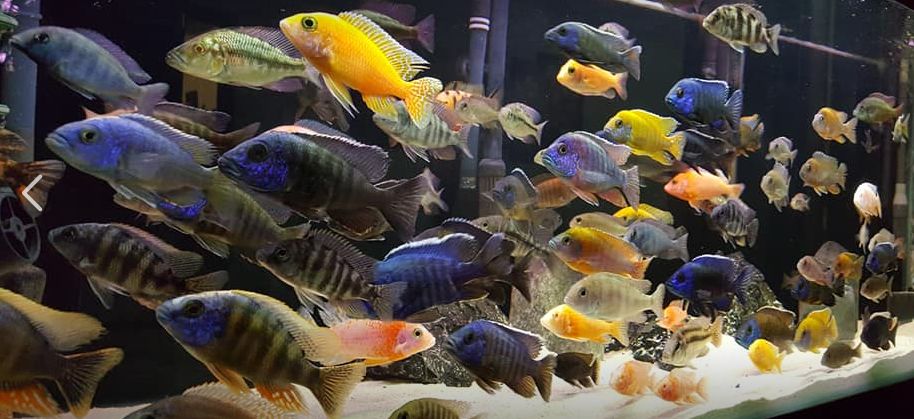
To calculate the “metabolic weight” of a fish, a scientific article was required. In the paper “Length-weight Relationship of Nigerian Freshwater Fishes”, Richard King, 1996, gave the weight factors for 73 tropical freshwater fish populations ranging in length from 1.5 cm to 22.5 cm. He defined the weight of the fish by the equation W = A x LB where A ranges from 0.003 to 0.6 and B ranges from 2 to 5. The mean values for A were very roughly about 0.02 and the mean values for B were very roughly about 3, or W = 0.02 L3 . But there was a HUGE, and I must emphasize HUGE, amount of variability.
This formula, W= 0.02 L3, is accurate for a tilapia per the literature. A ten centimeter (four inch) tilapia is thus 21 grams.
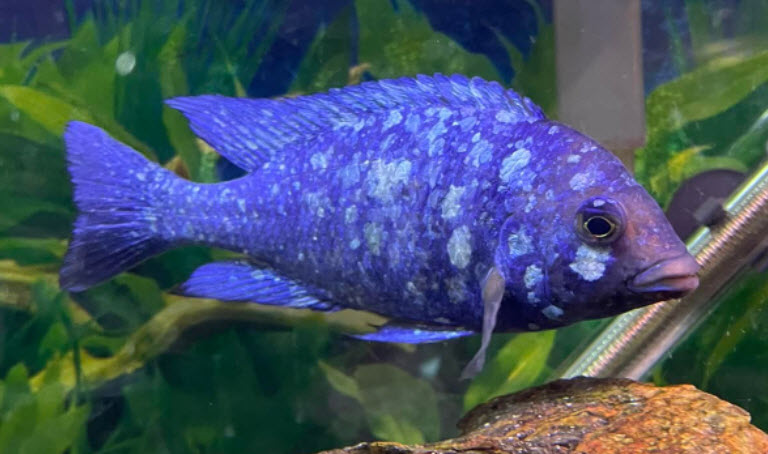
For trout, per the literature, the formula becomes:
- W = 0.036 L2.7
A ten centimeter (four inch) trout is thus 18 grams. This reflects the narrow streamlined shape of a trout.
For a catfish, per the literature, the equation becomes:
- W = 0.0127 L3.28
A ten centimeter (four inch) catfish is thus 24 grams. This reflects the fat wide body of a catfish.
Complicated enough for you? Note this range of 18 to 24 grams is MUCH less than intuition says it should be.
Another factor that then needs to be added in is a “metabolism factor”. Smaller fish move much faster on average than a larger fish. So the weight needs to be changed to account for this.

From experience, I know a 100-gallon aquarium can hold about 50 four inch (total length) mbuna (50 x 37.8 = 1,890 grams metabolic weight) with VERY heavy stocking and VERY heavy filtration. The length-weight-metabolism factors of the Nigerian study were then melded with the mbuna stocking numbers and the following chart was the result:
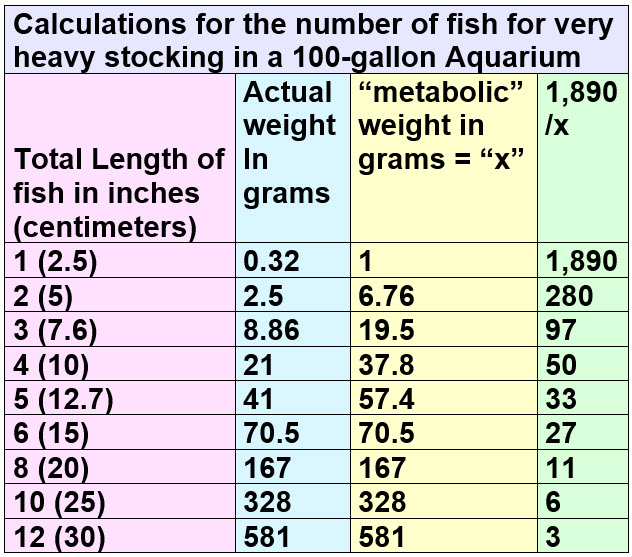
The “actual weight” was derived from the Nigerian study equation where W = 0.02 L3. The 1,890 number was obtained by multiplying 37.8 grams (weight of a four-inch fish per the study) by 50 four-inch fish (37.8 x 50 = 1,890).
One of my readers surveyed the aquarium literature and found that:
- female guppy with a Total Length of 4.5 cm (1.77 inches) weighs 1.4 grams on average
- platy-Xiphophorus maculatus of TL 4.8 cm (1.9 inches) is 1.8 grams average
- Danio rerio of 1-year-old with TL 4.5 cm (1.77 inches) is 0.67 grams
- 19 weeks young tiger barbs (Puntigrus tetrazona) average TL 3.7 cm (1.46 inches) and weigh 0.85 grams

This would say the weight numbers of King are higher for small fish than they should be. I revisited King to look at it. Another study that measured the length and weight of some juvenile Lake Malawi cichlids gave some more data (“Nutrition for Juvenile African Cichlids: the Effect of Varying Dietary Protein and Energy Levels on Growth Performance and Liver Condition” Royes, 2004). One reader (Jim O’Neill) did a rough measurement of the weight of some of his fish. Then there is the calculated weight per King. Putting it all together into a chart one gets:

So King (the “calculated weight”) is a little higher. But I’m sticking with his numbers. It is important to emphasize that this is a GROSS APPROXIMATION ONLY. This number varies a HUGE amount depending on body shape. Smaller fish tend to be less “stocky” than larger fish in the aquarium versus in the wild. So it is not surprising they have smaller actual weights than an average of wild fish would say.
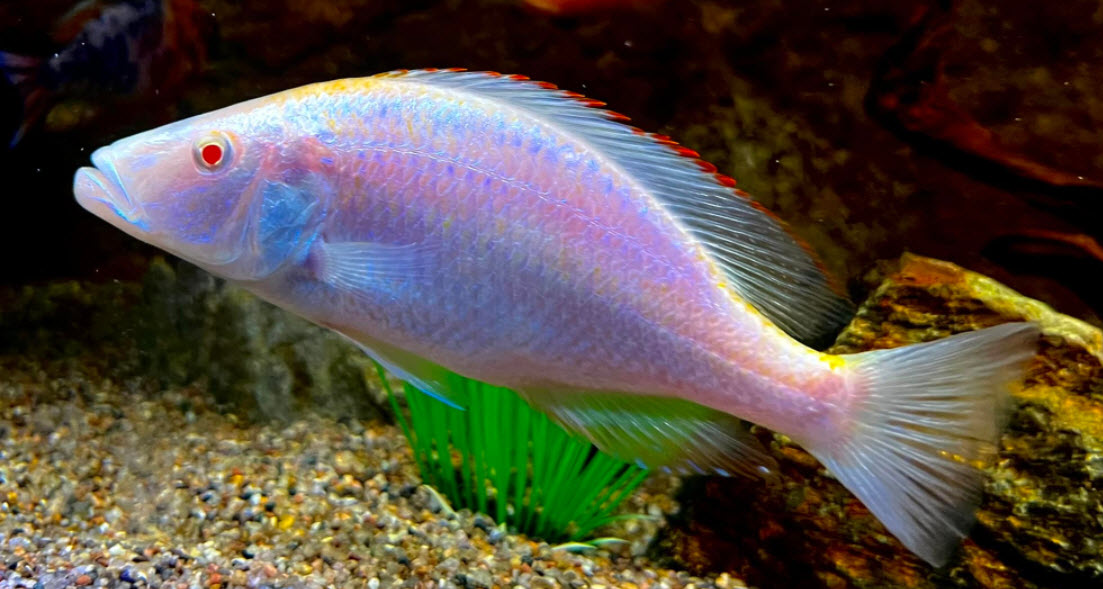
The last column in the “heavy stocking” chart above represents the number of fish that can go in an 100-gallon aquarium with very heavy stocking. The numbers reflect the metabolism change that occurs at three to nine inches. We can then break out the “light stocking”, “Maximum recommended” (or “moderate”) and “heavy stocking.
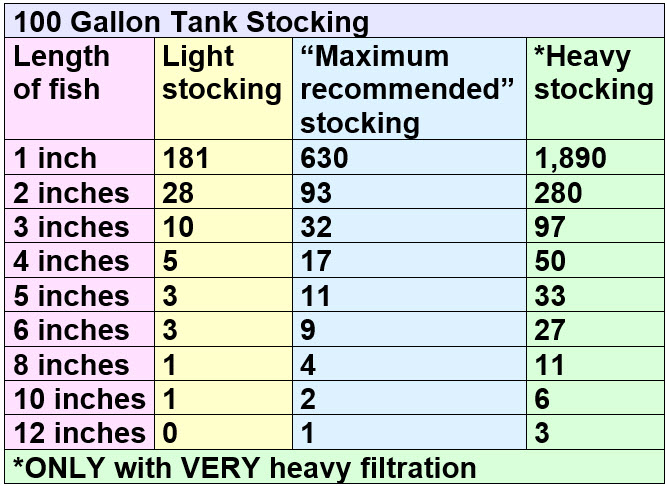
This chart is then divided by the appropriate number to get the stocking levels in the charts on the “13. Stocking” Page. These charts can be seen at this link:
13. Stocking
Now many will key in on the number “1,890” one-inch fish per 100 gallons and say “That is just ridiculous”. But the numbers are generally MUCH less than the stocking that several hundred university research centers use to stock zebrafish for genetic research.
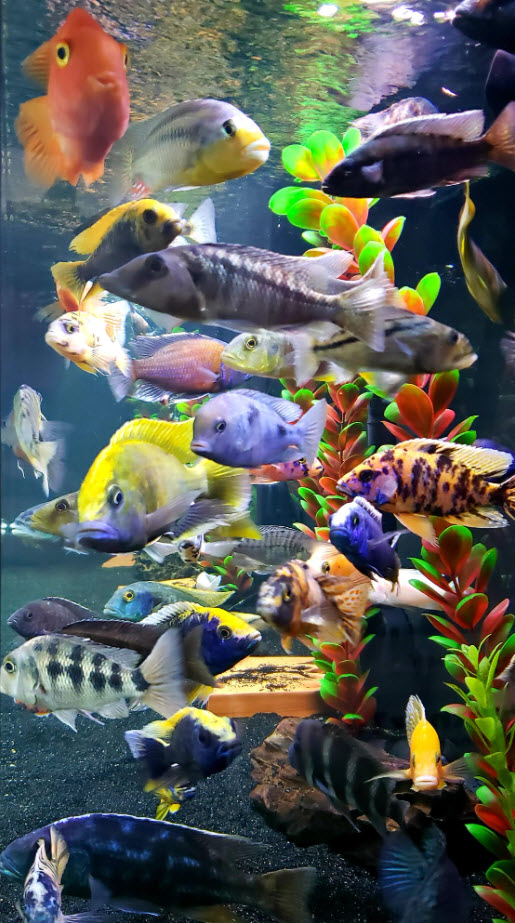
Many hobbyists use a website called AqAdvisor to find out if they are properly stocked and filtered. If you plug in the heavy stocking for a four inch fish above into the AqAdvisor calculator it will typically say “Your aquarium stocking level is 300%”. The “Your aquarium stocking level is 100%” recommended on AqAdvisor.com for a four-inch fish is roughly one-third the very heavy stocking level we calculate here-in, or a “moderate” level.
Note that the AqAdvisor.com website is just one person’s OPINION and the stocking calculator is NOT based on rational volume or weight considerations. For instance, the AqAdvisor calculator says 105 neons in a 100-gallon aquarium is the 100% stocking level (“Your aquarium stocking level is 100%” in AqAdvisor). This is a ridiculously low number of neons for a 100 gallon. Any 100 gallon can easily stock 500 neons at “moderate” stocking and 1500 neons at “heavy” stocking.
The “Your aquarium stocking level is 100%” weight recommended on AqAdvisor.com for a one-inch fish is only 18% of the “Your aquarium stocking level is 100%” weight of four-inch fish on the same site. It should be about 50% based on metabolism. It appears the AqAdvisor.com site is at least partially based on the incredibly inaccurate one inch per gallon rule, possibly something like the square of the length rather than the cube of the length.
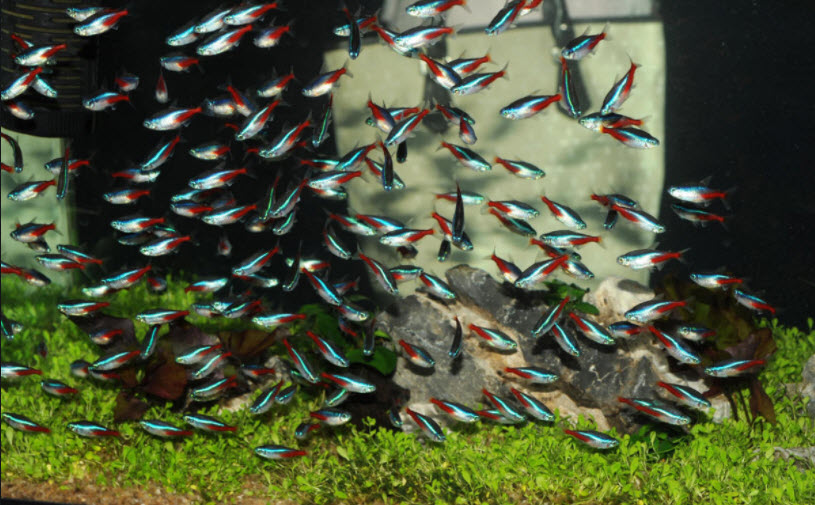
A 100-gallon aquarium can hold about 6 pounds (2,800 grams) of fish in heavy stocking, 2 pounds (900 grams) in moderate (“100% stocking level”) stocking, and 0.66 pounds (280 grams) in the light stocking. An eleven-inch Oscar will have a “metabolic” weight of 363, which means one can stock 2,800/363 or close to eight full-grown Oscars in a 100-gallon tank with VERY heavy stocking.
Note also that this is like every other aquarium variable. Namely “it depends”. If you have a superb large filter system, drip water changes, heavy aeration, your water parameters are perfect, etc. then it’s amazing how many fish you can stock.

Filtration and Stocking
Everyone in the hobby tends to make everything about the number of gallons in the aquarium. This is a mistake. It is possible to house very large fish in very small aquariums IF THE FILTRATION AND WATER CHANGES ARE SUFFICIENT!! I’ve seen a 50-gallon aquarium with two large (try one foot) Oscars which had been living there just fine for many years. There were two huge canister filters under the aquarium and the water was changed every three days by a drip water change system.
Remember the cardinal rule of filtration:
.
One Metabolic Pound of Fish Needs 100 Square feet Of Biomedia Surface Area
.
This amount of bio media give no nitrites, no ammonia, good water clarity, and good fish health.
There are ways to determine the amount of media and the amount of filtration needed for a given loading of fish. They can be found in the following link:
8.8. Sizing Filters and Media

Of course, there is always a downside to putting huge poundage of fish in a small aquarium. If the power goes out for more than an hour, fish in a heavily stocked aquarium will begin dying. I know, I lost a couple of thousand dollars of fish in a ten-hour power outage.
Anyone with heavily stocked aquariums must have a generator that can be set up in half an hour in the dark.
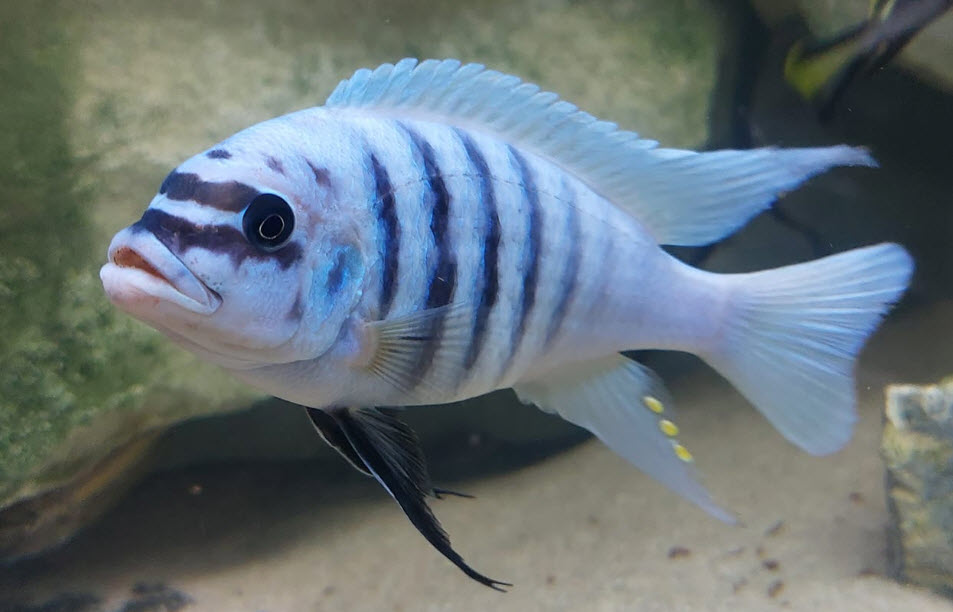
Filter Media
Now the common question here is “what do you mean by “good media”? Testing has shown some filter media to be much better than other filter media. This testing can be found in this article:
7.1.3. Filter Media Test
The green media below are what are considered “good media”:
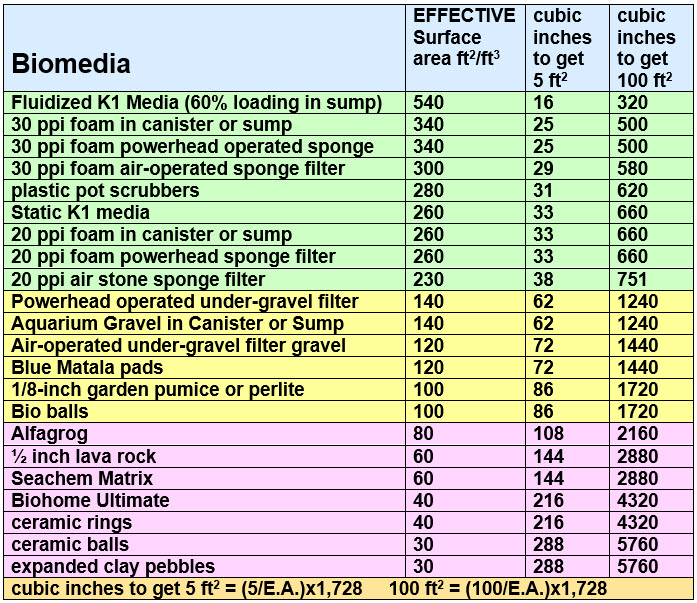
Stocking in Greater Depth
Hopefully the following links can put some common sense into this subject:
13.1. Stocking Opinions
13.3. Lifespan of the Fish
.
Return to Stocking Menu
.
Aquarium Science Website
The chapters shown below or on the right side in maroon lead to close to 400 articles on all aspects of keeping a freshwater aquarium. These articles have NO links to profit making sites and are thus unbiased in their recommendations, unlike all the for-profit sites you will find with Google. Bookmark and browse!
.

Ovidiu says
Hello, I bought a device to weigh out the food. I realised I was feeding at 0.1% a day, I dont know whether it is bad(maybe you could tell me, as there s little about underfeeding on the site). Also I always thought adult peacocks should be 6 inches or close to it, mine are 4 to 5 inches mostly.
Dave says
In reply to Ovidiu …. First off five inch peacocks are adults and should be fed 0.5% once a day. Secondly the density of pelleted food varies all over the map. So weigh it out, don’t use volume.
Ovidiu says
Hello, how does the weight of two fish eyeballs correlate to your other 0.5-1.5% body weight formula? How can I ever estimate the weight of a fish eyeball? (dry pellets).
Also assuming I have 20 peacock juvies in 75 gallon, that would be 20×57.4=1148 metabolic grams of 5 inch fish => 1148×0.015(1.5%)=17.22 grams of dry pellet food ~ 17.22/1.5(level teaspoon)=11 and a half teaspoons of dry pellet food. Is that correct? Because I have tried it for one day and there was A LOT of uneated food remaining. Am I missing something?
Dave says
In reply to Liudmila ….. An apple snail is probably equivalent to a four inch fish
Liudmila says
What about snails? They also add bio-load. How to fit them into stocking calculations? I have one large Apple snail and it shits *a lot*. 😀